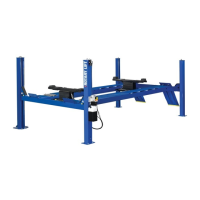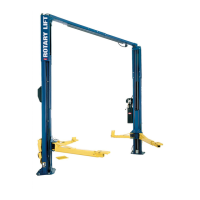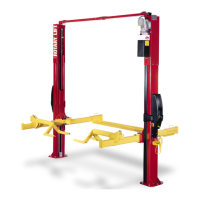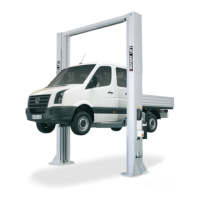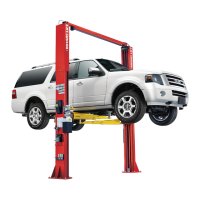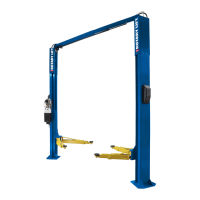4
OPERATINGINSTRUCTIONS
To avoid personal injury and/or property dam-
age, permit only trained personnel to operate lift.
IMPORTANT
Always lift vehicle using all four tires. Never
raise just one end, corner or one side of vehicle.
After reviewing these instructions, get familiar with lift controls by
running the lift through a few cycles before loading vehicle on lift.
If lift is not operating properly, DONOT use un-
til adjustments or repairs are made by a qualified lift service
technician.
Observe and heed SAFETY and WARNING labels on the lift.
NOTE: This lift was designed for 121-1/2” or longer wheelbase at
the rated 12,000 lb.
1. Loading:
A. Lift must be fully lowered and service bay clear of all
personnel before the vehicle is brought on lift. Do not
stand in front of a moving vehicle.
B. If lift is equipped with wheels free device, it must be fully
lowered and the rear wheels free device pushed toward
center of lift to provide under car clearance.
C. Stop vehicle when it contacts the front wheel stops.
At all times, be sure rear wheels are forward of
the ramp/chocks and the ramp/chocks will clear tires
when the lift is raised, Fig. 1. Driver and passengers
must exit before raising.
D. Place triangular wheel chocks on each side of one of the
rear tires, Fig. 1.
2. ToRaiseLift:
A. Push the “RAISE” button on the control panel. Release
button at desired height, Fig. 2.
B. Lower lift to locking latches by pushing the “LOWERTO
LOCKS” button until light turns off, Fig. 2.
IMPORTANT
Always lower lift on locking latches before align-
ment readings are measured.
C. For Wheels Free Device Operating Instructions see
Wheels Free Device Installation, Operation and Mainte-
nance Instructions in the wheels free device shipping
carton.
CAUTION
DONOT go under vehicle or lift if locking latches
are not engaged.
WARNING
Never raise lift while vehicle is supported
above the runway by the wheels free device.
3. BeforeLoweringLift:
A. Be sure no one is in the lift area and that all tools, tool
trays, etc. have been removed from under the lift and
vehicle.
Observe pinch point warning decals, Fig. 3.
B. If lift is equipped with wheels free device, it must be fully
lowered and the rear wheels free device pushed toward
center of lift to provide under car clearance.
4. ToLowerLift:
A. Raise lift off locking latches by pushing the “RAISE”
button, Fig. 2.
Note: If actuator on air valve is released, the latches will auto-
matically reset to the engaged position.
B. Push the “Lowering” button to lower lift, Fig. 2.
C. Observe lift and vehicle to be sure lift is level while being
lowered. If not, STOP raise lift by pressing the “Raise”
button until runways are level and repeat the lowering
process.
D. Fully lower lift, remove the triangular wheel chocks and
check to be sure area is clear before removing vehicle
from lift, Fig. 1.
Keep hands clear of linkages while the lift is
being raised or lowered, Fig. 3.
Never lower lift while vehicle is supported
above the runway by the wheels free device.
Before attempting to lift pick-up trucks or other
truck frame vehicles, be sure that:
A. Vehicle individual axle weight does not exceed one-half
lift capacity.
B. Adequate overhead clearance is provided to raise
vehicles to desired height.
Note: Allow 2 seconds between motor starts. Failure to comply
may cause motor burnout.
*Maximum operation pressure is:
3250 psi for Y12/YA12
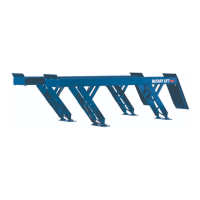
